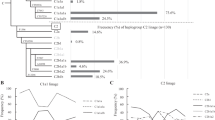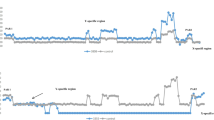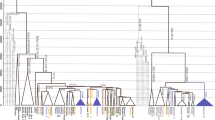Abstract
A recurrent partial azoospermia factor C (AZFc) deletion, called gr/gr, has been reported to be a male infertility risk factor. A specific type of Y chromosome observed in approximately 30% of Japanese males (haplogroup D derived at YAP+) is believed to have a fixed gr/gr deletion. A recent study claimed that spermatogenic failure is more likely in males with D Y chromosomes, because of the gr/gr deletion, the presence of which is not well characterized among D haplogroup chromosomes. We therefore decided to perform a systematic study of the frequency of the gr/gr deletion in the Japanese. We studied fertile and infertile males to investigate the possibility of different gr/gr frequencies. The deletions were detected by use of single tagged-sequences (STSs) and the D haplogroup sub-lineages typing were done by use of the biallelic markers M174, M64, M116.1, 12f2.2, M15, M151, and M125. Analysis of gr/gr deleted Y chromosomes showed that all are classified as haplogroup D2, suggesting a lineage association. The subtype D2b1 was most frequent among the Japanese, in control and infertile samples. The haplogroups D2b2, D*, and D1 were not found in any population group. Remarkably, we observed no statistical difference between haplogroup D sub-lineages of the infertile and control groups, although the statistical power of this study is low. This study suggests lack of significant evidence of increased infertility risk in haplogroup D Japanese males. We were also able to establish the ancestral chromosome that suffered a gr/gr deletion, and propose a new Y chromosome phylogeny for haplogroup D and its derivatives. In summary, we were able to define the frequency of gr/gr deletion in Japanese males and show that the gr/gr deletion was probably present in the ancestral Y chromosome that entered Japan at least 12,000 years ago.
Similar content being viewed by others
Log in or create a free account to read this content
Gain free access to this article, as well as selected content from this journal and more on nature.com
or
References
Carvalho CMB, Fujisawa M, Shirakawa T, Gotoh A, Kamidono S, Paulo TF, Santos SEB, Rocha J, Pena SDJ, Santos FR (2003) Lack of association between Y chromosome haplogroups and male infertility in Japanese men. Am J Med Genet 116A:152–158
Carvalho CMB, Santos FR (2005) Human Y-chromosome variation and male dysfunction. J Mol Genet Med 1:63–75
Carvalho CMB, Pena SDJ (2005) Optimization of a multiplex minisequencing protocol for population studies and medical genetics. Genet Mol Res 4:115–125
Carvalho CM, Zuccherato LW, Bastos-Rodrigues L, Santos FR, Pena SD (2006) No association found between gr/gr deletions and infertility in Brazilian males. Mol Hum Reprod 12:269–283
Deng W, Shi B, He X, Zhang Z, Xu J, Li B, Yang J, Ling L, Dai C, Qiang B, Shen Y, Chen R (2004) Evolution and migration history of the Chinese population inferred from Chinese Y-chromosome evidence. J Hum Genet 49:339–348
Fernandes S, Paracchini S, Meyer LH, Floridia G, Tyler-Smith C, Vogt PH (2004) A large AZFc deletion removes DAZ3/DAZ4 and nearby genes from men in Y haplogroup N. Am J Hum Genet 74:180–187
Fujisawa M, Shirakawa T, Kanzaki M, Okada H, Arakawa S, Kamidono S (2001) Y-chromosome microdeletion and phenotype in cytogenetically normal men with idiopathic azoospermia. Fertil Steril 76:491–495
Hammer MF, Horai S (1995) Y chromosomal DNA variation and the peopling of Japan. Am J Hum Genet 56:951–962
Hammer MF, Karafet TM, Park H, Omoto K, Harihara S, Stoneking M, Horai S (2006) Dual origins of the Japanese: common ground for hunter-gatherer and farmer Y chromosomes. J Hum Genet 51:47–58
Hucklenbroich K, Gromoll J, Heinrich M, Hohoff C, Nieschlag E, Simoni M (2005) Partial deletions in the AZFc region of the Y chromosome occur in men with impaired as well as normal spermatogenesis. Hum Reprod 20:191–197
Jin HJ, Kwak KD, Hammer MF, Nakahori Y, Shinka T, Lee JW, Jin F, Jia X, Tyler-Smith C, Kim W (2003) Y-chromosomal DNA haplogroups and their implications for the dual origins of the Koreans. Hum Genet 114:27–35
Jobling MA, Tyler-Smith C (2003) The human Y chromosome: an evolutionary marker comes of age. Nat Rev Genet 4:598–612
Jobling MA, Samara V, Pandya A, Fretwell N, Bernasconi B, Mitchell RJ, Gerelsaikhan T, Dashnyam B, Sajantila A, Salo PJ (1996) Recurrent duplication and deletion polymorphisms on the long arm of the Y chromosome in normal males. Hum Mol Genet 5:1767–1775
Katoh T, Munkhbat B, Tounai K, Mano S, Ando H, Oyungerel G, Chae GT, Han H, Jia GJ, Tokunaga K, Munkhtuvshin N, Tamiya G, Inoko H (2005) Genetic features of Mongolian ethnic groups revealed by Y-chromosomal analysis. Gene 346:63–70
Kuroda-Kawaguchi T, Skaletsky H, Brown LG, Minx PJ, Cordum HS, Waterston RH, Wilson RK, Silber S, Oates R, Rozen S, Page DC (2001) The AZFc region of the Y chromosome features massive palindromes and uniform recurrent deletions in infertile men. Nat Genet 29:279–286
Kuroki Y, Iwamoto T, Lee J, Yoshiike M, Nozawa S, Nishida T, Ewis AA, Nakamura H, Toda T, Tokunaga K, Kotliarova SE, Kondoh N, Koh E, Namiki M, Shinka T, Nakahori Y (1999) Spermatogenic ability is different among males in different Y chromosome lineage. J Hum Genet 44:289–292
de Llanos M, Ballesca JL, Gazquez C, Margarit E, Oliva R (2005) High frequency of gr/gr chromosome Y deletions in consecutive oligospermic ICSI candidates. Hum Reprod 20:216–220
Lynch M, Cram DS, Reilly A, O’Bryan MK, Baker HW, de Kretser DM, McLachlan RI (2005) The Y chromosome gr/gr subdeletion is associated with male infertility. Mol Hum Reprod 11:507–512
Machev N, Saut N, Longepied G, Terriou P, Navarro A, Levy N, Guichaoua M, Metzler-Guillemain C, Collignon P, Frances AM, Belougne J, Clemente E, Chiaroni J, Chevillard C, Durand C, Ducourneau A, Pech N, McElreavey K, Mattei MG, Mitchell MJ (2004) Sequence family variant loss from the AZFc interval of the human Y chromosome; but not gene copy loss; is strongly associated with male infertility. J Med Genet 41:814–825
Ravel C, Chantot-Bastaraud S, El Houate B, Mandelbaum J, Siffroi JP, McElreavey K (2006) GR/GR deletions within the azoospermia factor c region on the Y chromosome might not be associated with spermatogenic failure. Fertil Steril 85:229–231
Repping S, Skaletsky H, Brown L, van Daalen SK, Korver CM, Pyntikova T, Kuroda-Kawaguchi T, de Vries JW, Oates RD, Silber S, van der Veen F, Page DC, Rozen S (2003) Polymorphism for a 1.6-Mb deletion of the human Y chromosome persists through balance between recurrent mutation and haploid selection. Nat Genet 35:247–251
Repping S, van Daalen SK, Korver CM, Brown LG, Marszalek JD, Gianotten J, Oates RD, Silber S, van der Veen F, Page DC, Rozen S (2004) A family of human Y chromosomes has dispersed throughout northern Eurasia despite a 1.8-Mb deletion in the azoospermia factor c region. Genomics 83:1046–1052
Repping S, van Daalen SK, Brown LG, Korver CM, Lange J, Marszalek JD, Pyntikova T, van der Veen F, Skaletsky H, Page DC, Rozen S (2006) High mutation rates have driven extensive structural polymorphism among human Y chromosomes. Nat Genet 38:463–467
Rosser Z, Zerjal T, Hurles ME, Adojaan M, Alavantic D, Amorim A, Amos W et al (2000) Y-chromosomal diversity within Europe is clinal and influenced primarily by geography rather than language. Am J Hum Genet 67:1526–1543
Santos FR, Bianchi NO, Pena SD (1996) Worldwide distribution of human Y-chromosome haplotypes. Genome Res 6:601–611
Shinka T, Tomita K, Toda T, Kotliarova SE, Lee J, Kuroki Y, Jin DK, Tokunaga K, Nakamura H, Nakahori Y (1999) Genetic variations on the Y chromosome in the Japanese population and implications for modern human Y chromosome lineage. J Hum Genet 44:240–245
Suchneider S, Roessli D, Excoffier L (2000) Arlequin ver. 2.000: a software for population genetic data analysis. Genetic and Biometry Laboratory, University of Geneva, Geneva, Switzerland
Tajima A, Pan IH, Fucharoen G, Fucharoen S, Matsuo M, Tokunaga K, Juji T, Hayami M, Omoto K, Horai S (2002) Three major lineages of Asian Y chromosomes: implications for the peopling of east and southeast Asia. Hum Genet 110:80–88
The Y Chromosome Consortium (2002) A nomenclature for the tree of human Y-chromosomal binary haplogroups. Genome Res 12:339–348
Underhill PA, Shen P, Lin AA, Jin L, Passarino G, Yang WH, Kauffman E, Bonne-Tamir B, Bertranpetit J, Francalacci P, Ibrahim M, Jenkins T, Kidd JR, Mehdi SQ, Seielstad MT, Wells RS, Piazza A, Davis RW, Feldman MW, Cavalli-Sforza LL, Oefner PJ (2000) Y chromosome sequence variation and the history of human populations. Nat Genet 26:358–361
Underhill PA, Passarino G, Lin AA, Shen P, Mirazon Lahr M, Foley RA, Oefner PJ, Cavalli-Sforza LL (2001) The phylogeography of Y chromosome binary haplotypes and the origins of modern human populations. Ann Hum Genet 65:43–62
Acknowledgments
We would like to thank anonymous sample donors, who enabled this work to be performed. We also thank Neuza Antunes, Kátia Barroso, and Míriam Rodrigues for technical assistance. This work was supported by the Brazilian agency CNPq.
Author information
Authors and Affiliations
Corresponding author
Electronic supplementary material
Rights and permissions
About this article
Cite this article
de Carvalho, C.M.B., Zuccherato, L.W., Fujisawa, M. et al. Study of AZFc partial deletion gr/gr in fertile and infertile Japanese males. J Hum Genet 51, 794–799 (2006). https://doi.org/10.1007/s10038-006-0024-2
Received:
Accepted:
Published:
Issue date:
DOI: https://doi.org/10.1007/s10038-006-0024-2
Keywords
This article is cited by
-
Detection of AZFc gene deletion in a cohort of Egyptian patients with idiopathic male infertility
Journal of Genetic Engineering and Biotechnology (2023)
-
Do partial AZFc deletions affect the sperm retrieval rate in non-mosaic Klinefelter patients undergoing microdissection testicular sperm extraction?
BMC Urology (2020)
-
Partial-AZFc deletions in Chilean men with primary spermatogenic impairment: gene dosage and Y-chromosome haplogroups
Journal of Assisted Reproduction and Genetics (2020)
-
High frequencies of Non Allelic Homologous Recombination (NAHR) events at the AZF loci and male infertility risk in Indian men
Scientific Reports (2019)
-
Spermatogenic failure and the Y chromosome
Human Genetics (2017)



